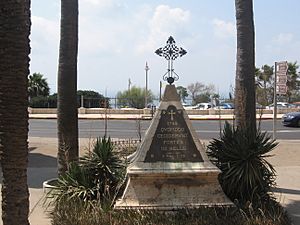Siege of Jaffa facts for kids
Quick facts for kids Siege of Jaffa |
|||||||
|---|---|---|---|---|---|---|---|
| Part of the French Campaign in Egypt and Syria during the War of the Second Coalition | |||||||
|
|||||||
| Belligerents | |||||||
|
|||||||
| Commanders and leaders | |||||||
| Strength | |||||||
| 10,000 | 5,000 mostly Albanian troops | ||||||
| Casualties and losses | |||||||
| 50 killed 200 wounded |
2,000 killed 2,100 prisoners executed |
||||||
The Siege of Jaffa was a battle between the French army led by Napoleon Bonaparte and Ottoman soldiers led by Ahmed al-Jazzar. On March 3, 1799, the French army surrounded the city of Jaffa, which was controlled by the Ottomans. The fighting lasted until March 7, 1799, when French forces successfully captured the city.
Why the Battle Happened
Napoleon Bonaparte had taken control of Alexandria and Cairo in Egypt. Even though his ships were destroyed, he continued his plan to push into the Ottoman Empire's lands in the Middle East.
He had recently captured an Ottoman fort at El Arish. Napoleon wanted to make his control stronger in the area known as the Levant. In early March, his troops arrived at Jaffa, which is part of modern Tel Aviv.
The Siege of Jaffa
The city of Jaffa was protected by tall, strong walls. The Ottomans had also built many defenses around it. Ahmed al-Jazzar put his soldiers in charge of defending Jaffa. This included 1,200 artillerymen, who were experts with cannons.
Napoleon needed to capture Jaffa to continue his journey. The success of his entire mission depended on taking the city. Jaffa was a major trading center in Greater Syria. It also had a harbor that would be very useful for the French fleet.
The French could attack the outer defenses and create a break in the walls. Napoleon sent an officer to Ahmed al-Jazzar to demand that the city surrender. However, Ahmed al-Jazzar executed the messengers. He then ordered his troops to attack the French outside the city.
This attack was quickly pushed back by the French on the same evening. The French managed to destroy one of the towers on the city's walls. Despite strong resistance from the defenders, Jaffa was captured.
After the city fell, Napoleon made a difficult decision. He ordered that a large number of the Ottoman prisoners be executed. Many of these prisoners were Albanians. Some reports say about 2,440 prisoners were executed, while others suggest it was around 4,100.
Historians who supported Napoleon later explained this decision. They said that keeping so many prisoners would have meant using many French soldiers as guards. This would have made Napoleon's army much smaller. Also, if the prisoners were set free, they might have joined Ahmed al-Jazzar's army again.
What Happened Next
Napoleon allowed hundreds of local citizens to leave Jaffa. He hoped that when they told others about Jaffa's fall, it would scare the defenders of other cities. However, this plan did not work. Instead, the news made other cities fight even harder.
Around this time, a serious sickness, like the plague, spread. It was caused by poor hygiene in the French headquarters in Ramla. This sickness affected both the local people and the French army.
Later, Napoleon's army faced strong resistance from the Ottomans in the north. Because of this, Napoleon left the area of Palestine. After he left, the British, who were allies with the Ottomans, helped rebuild Jaffa's city walls. The British forces were led by William Sidney Smith.
Years later, from 1800 to 1814, Jaffa was again taken over by Napoleon's former opponent, Ahmed al-Jazzar, who was the governor of Acre.
|


